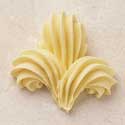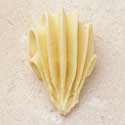All About Cheese
This cheese is the French version of the Dutch Edam cheese. It features a distinctive, red wax coating.
Country: France
Milk: cow milk
Texture: soft
» Camembert de Normandie «
A very famous French cheese, Camembert dates back to the 18th century and is named for a Norman village in which there is a statue of the creator of this particular variety (Marie Harel). Originally, this cheese was dry and yellow-brown, but after a few modifications it became softer and more earthy. In 1855 one of Marie Harel's daughters presented Napoleon with a piece of that cheese, saying that it came from village called Camembert. He liked it a lot and from that moment Camembert became known by its contemporary name. At the beginning of its ripening, Camembert is crumbly and soft and gets creamier over time (usually 2-3 weeks). A genuine Camembert has a delicate salty taste.
Country: France
Milk: cow milk
Texture: soft
Fat content: 45 %
» Baby Swiss «
Its appearance and texture is ivory to pale yellow. It is a creamy cheese with small holes and it melts well when shredded. Baby Swiss has a buttery, slightly nutty and sweet flavor. It goes well with sweet fruits and berries croissants and muffins, white and red wine, juices and even ice-cold milk.
Milk: cow milk
Texture: semi-soft
» Cantal «
The oldest of all French cheeses, dating back to the time of the Gauls. The cheese is shaped like a cylinder, one foot in diameter. There are two types of Cantal: Cantal fermier (farmhouse cheese using raw milk) and Cantal laitier (the commercial mass-produced version). Milk is heated to 90 degrees F and curdled with liquid rennet. Curd is cut into tiny pieces and when the whey has been drawn off, curd is pressed and sliced, then moulded. Cantal is cured for 3 months at 50 degrees F. This cheese is the grandfather of the cheeses from the Auvergne region. Over the years, its reputation has appealed to more and more cheese lovers. The form of the cheese is massive and dumpy, with a soft interior. Auvergne is a region known for a thousand volcanoes, blessed by mountain storms and summer sun, the pasture lands are extremely fertile. Cantal cheese captures all the richness of these pasture lands. A well-ripened Cantal has a vigorous taste, whereas a young cheese has the sweetness of raw milk. The "pâte" is firm and homogeneous, with a thick, smooth, dry, grayish-brown rind. Its smell is of the good earth and rich pasture lands. The taste has a tangy butter taste. A fine example of a country cheese.
Country: France
Milk: cow milk
Texture: semi-hard
Fat content: 45 %
» Cheddar «
The most widely purchased and eaten cheese in the world. Cheddar cheeses were originally made in England, however today they are manufactured in many countries all over the world. Fully cured Cheddar is a hard, natural cheese. It is shaped like a drum, 15 inches in diameter, with natural rind bound in cloth. Normally, the color of Cheddar ranges from white to pale yellow. Some Cheddars, however, have a color added, giving the cheese a yellow-orange color. Cheddar is always made from cow's milk and has a slightly crumbly texture if properly cured. If the cheese is too young, the texture is smooth. Cheddar gets a sharper taste the longer it matures. It is generally matured between 9 and 24 months. The important thing in purchasing Cheddar, is to consider the age of the cheese. Milk is heated to 86 degrees F and inoculated with a lactic starter culture. After an hour rennet is added. When the curd is firm, it is ground down to marble-sized bits which are heated to 100 degrees F. The whey is discarded and it is sliced into slabs. The curd is pressed overnight and stands for 4 days in a cool atmosphere. Unlike other well known cheeses, Cheddar's name is not protected so it has been used and abused by many producers around the world.
Country: England
Milk: cow milk
Texture: semi-hard
Fat content: 48 %
» Cheddar Clothbound «
Old England tradition meets New England flavor. Our single breed, small batch cheddar is cave-aged in Jasper Hill Farm’s cellars. Buttery flavor with caramel undertones.
Country: US Vermont
» Cottage Cheese «
Snow-white cottage cheese which is produced in United States, Britain and other countries. It is a creamy, lumpy cheese sold in pots. It is an acid curd cheese, relying on the natural tendency of warm milk to curdle (no use of rennet). Once the floppy curd has formed, it is cut into pieces and heated gently in whey until it reaches desired texture. Then the whey is removed (by draining and rinsing). This cheese ripens in one or two days and has a fat content of five to 15 per cent.
Milk: cow milk
Texture: soft
» Cottage Cheese (Australian) «
Australian Cottage Cheese is a low fat, soft, white cheese with a paste-like, grainy consistency. Creamed Cottage Cheese has a curd that is washed and then a cream dressing is added. They are fresh, unripenned cheeses that have a high moisture content, delicate, creamy flavor and short shelf life.
Country: Australia
Texture: soft
» Coulommiers «
This cheese is Brie's little brother, some people consider it the grandfather. It usually has a shape of disc with white penicillin mould made from cow's milk. It is smaller and thicker than Brie but otherwise possesses all the characteristics of a Brie. This cheese can be either fermier or industrially produced, though industrial version lacks the depth of an unpasteurized cheese. The period of ripening is about four weekend the content of fat is 40 per cent.
Country: France
Milk: cow milk
Texture: soft
Fat content: 40 %
>> Cream Cheese <<
It is a modern, fresh cheese made of cow's milk. It is an acid curd cheese, but unlike cottage cheese, it requires a starter culture of bacteria. It is generally mild and velvety. Sometimes whey powder is added which results in more grainy texture of cheese. Perfect for cheesecakes and baking.
Country:
Milk:
cow milk
Texture:
soft
» Creme Fraiche «
A rich, thick cream cheese which is faintly soured. Wonderful over fruits and desserts, it is not a true cheese. Creme Fraiche is made by adding a culture to a fresh cream.
Milk: cow milk
Texture: soft
» Dry Jack «
It is a square-shaped, unpasteurized, vegetarian, hard cheese with rounded edges. The natural rind is hand-rubbed with oil, cocoa and pepper. This cheese was created in 1915 by San Francisco wholesaler, but today it is made by the Vella Cheese Company. The rind looks like chocolate icing. Underneath, the deep yellow cheese is hard, sweet and fruity with a taste of wine.
Country: United States
Milk: cow milk
Texture: hard
» Edam «
This is a pressed, semi-hard to hard cheese, made from cow's milk. It comes in a shape of ball covered with distinctive red wax. Edam is produced from skimmed or semi-skimmed milk. It is usually consumed young, when the texture is elastic and supple and the flavor is smooth, sweet and nutty. Black-wax coating means that Edam has been matured for at least 17 weeks. The cheese tastes delicious with a glass of Pinot Noir.
Country: Holland
Milk: cow milk
Texture: semi-hard
Fat content: 40 %
» Emental Grand Cru «
This cheese has a red label, which is a kind of guarantee of its quality. It is a large cheese with cooked and pressed pâté made from raw cow's milk. The rind is dry, washed and brushed. Emental Grand Cru has a sweet taste and aroma. Affinage takes at least ten weeks.
Country: France
Milk: cow milk
Fat content: 45 %
» Emmental «
This cheese is produced in the central cantons of Switzerland. It is a traditional, unpasteurized, hard cheese made from cow's milk. It's hard, thin rind is covered by paper with producer's name on it. The aroma is sweet with tones of fresh-cut hay. The flavor is very fruity, not without a tone of acidity. Emmental has walnut-sized holes. It is considered to be one of the most difficult cheeses to be produced because of it's complicated hole-forming fermentation process. The cheese tastes delicious with a glass of wine, for example Jura Blanc.
Country: Switzerland
Milk: cow milk
Texture: hard
» Feta «
Feta is one of the most famous cheeses in Greece. It is made in various sizes, often as a loaf-shape. Feta is solid, but crumbly with some fissures. Pure white, it has a milky fresh acidity. Feta was originally made with either ewe's milk or a mixture of ewe's and goat's milk, but today most feta is made with pasteurized milk and tastes of little besides salt. Some people are put off by the strong salt content but the salt is intended only as a preservative and is not supposed to overpower the taste of the cheese. Feta can be soaked in fresh, cold water or milk for a few minutes or longer, if necessary, to make it less salty. It has a fat content of 40 - 50%.
Country: Greece
Milk: cow ewe and goat milk
Texture: soft
» Feta (Australian) «
Australian Feta, made with cow's milk is a semi-soft, white cheese with a unique texture and flavor due to its manufacturing process. Initially a fresh cheese, Feta is sometimes described as a 'pickled' cheese because once it has been made, it is stored in a brine bath for a maturing period of at least 8 weeks. The brine salts the cheese and keeps it moist. When mature, Feta has a white, moist body and can be soft, firm or even ‘crumbly’ in texture. Australian Feta is a milder and creamier cheese than imported varieties and tends to slice easier and is less crumbly.
Country: Australia
Milk: cow milk
Texture: semi-soft
» Four Herb Gouda «
It is an organic, vegetarian, hard cheese of boulder-shape with waxed, natural rind. This cheese was made by Rients Rympa. Four Herb Gouda has a creamy, rich and nutty taste and the flavor of fresh, finely cut herbs. Affinage takes three to six months. Other very famous cheeses made by Rients Rympa are Leyden, Maasdam, plain Gouda and Quark.
Country: New Zealand
Milk: cow milk
Texture: hard
» Fresh Mozzarella «
Fresh cheeses are always mild and high in moisture and therefore low in fat. They have a slightly acidic or lactic taste. Most are used for cooking but some may be wrapped in leaves or dusted with paprika, charcoal or fresh herbs for serving as table cheese.
Country: Italy
Milk: cow and buffalo milk
Texture: soft
» Fresh Ricotta «
Light, delicate and moist. Made from whey so it's low in fats and calories and contains a lot of vitamins. Another very famous type of fresh cheeses.
Country: Italy
Milk: cow and ewe milk
Texture: soft
» Gouda «
Named after the Dutch town of Gouda, just outside Rotterdam. It accounts for more than 60% of the cheese produced in Holland and it has a very long history. Gouda is a traditional, creamery, hard cheese. It is round with very smooth, yellow, waxed rind. The flavor is sweet and fruity. As time passes, the taste intensifies and becomes more complex. Mature Gouda (18 months plus) is coated in black wax which provides a stark contrast to the deep yellow interior. Gouda is considered to be one of the world's great cheeses. It is both a table cheese and a dessert cheese, excellent with fruit and wine. Gouda is now made globally in a style similar to the creation of Edam.
Country: Holland
Milk: cow milk
Texture: semi-hard
» Gruyere «
Gruyere is named after a Swiss village. It is traditional, creamery, unpasteurized, semi-soft cheese. The natural, rusty brown rind is hard, dry and pitted with tiny holes. The cheese is darker yellow than Emmental but the texture is more dense and compact. Slightly grainy, the cheese has a wonderful complexity of flavors - at first fruity, later becomes more earthy and nutty. To make Gruyere, raw milk is heated to 93 degrees F and liquid rennet is added for curdling. The resulting curd is cut into small pieces which release whey while being stirred. Curd is cooked at 110 degrees F and raised quickly to 130 degrees F. The pieces become shriveled which is the cue to place the curd in molds for pressing. The cheese is salted in brine for 8 days and ripened for two months at room temperature or a quick method: 10 days at 50 degrees F. Curing lasts from 3 to 10 months (the longer the curing period the better the cheese).
Country: Switzerland
Milk: cow milk
Texture: hard
» Heidi Gruyere «
Heidi Gruyere is a vegetarian hard cheese made from cow's milk. This cheese has a firm texture, similar to French Beaufort, with tiny, crunchy crystals. The sweet, fruity taste suggests pineapple. The more mature the cheese, the better it tastes.
Country: Australia
Milk: cow milk
Texture: hard
Fat content: 45 %
» La Vache Qui Rit «
It comes wrapped in the little foiled portions and they came in the round disk box. You have to pull the little red thread around the box to open it. It is a smooth, sweet, buttery cheese famous all over the world with the picture of a smiling cow. This cheese is delicious for breakfast and snacks. (thanx Astrid)
Country: France
Milk: cow milk
Texture: soft
» Lebbene «
Lebbene is a cheese shaped into small balls and often known in the Middle East. It is called Lebney in Syria, Labaneh in Jordan and Gibne in the Arabian peninsula. This cheese is made of sheep's or goat's milk and is eaten young, almost liquid. The fat content is 45%.
Milk: ewe and goat milk
Texture: soft
Fat content: 45 %
» Maasdam «
Modern, creamery, semi-hard cheese made from cow's milk. It is boulder-shaped cheese. The smooth, natural rind is polished and may be waxed. The cheese was created in the early 1990's as an alternative to more expensive Swiss cheese Emmental. Although there are similarities with Emmental, it is higher in moisture and therefore, more supple. It ripens faster than other Dutch cheeses, being ready in four to 12 weeks. The flavor is sweet and buttery, with a fruity background, making it ideal for serving as a snack or breakfast cheese. It can also be grilled.
Country: Holland
Milk: cow milk
Texture: semi-hard
» Mascarpone «
A soft, white, fresh, vegetarian, cream cheese from the Lombardy region of southern Italy. In fact, it is not cheese at all, but rather the result of a culture being added to the cream skimmed off the milk, used in the production of Parmesan. It is, however, described as a curd cheese, although it is made in much the same way as yogurt. To make Mascarporne cheese tartaric acid (natural vegetable acid derived from the seed of the tamarind tree) is needed. After the culture has been added, the cream is gently heated, then allowed to mature and thicken. This whitish to straw-yellow, creamy, mild fresh cheese is compact, but supple and spreadable and it is added to famous Italian desserts, sometimes accompanied by cognac. Frequently it is used for the preparation of certain dishes and sauces. It takes only a few days to ripen and has a fat content of 75 per cent.
Country: Italy
Milk: cow milk
Texture: soft
Fat content: 75 %
» Ricotta «
Traditional, creamery, whey cheese made from cow's milk. It is a basin-shaped cheese, pure white and wet but not sticky. Good Ricotta should be firm, not solid and consist of a mass of fine, moist, delicate grains, neither salted nor ripened. It is white, creamy and mild and is primarily used as an ingredient in lasagna. It is primarily made with cow's milk whey which is heated to 170 degrees F. Citric acid is added to encourage destabilization and separation and the temperature is quickly raised to 185 degrees F. Proteins from the whey separate rise and coagulate; the proteins (lactalbumin) are skimmed off and put in a wicker basket to drain for two days after which the "cheese" is ready for market. There are three distinct varieties of ricotta: ricotta salata moliterna (ewe's milk whey), ricotta piemontese (cow's milk whey + 10% milk) and ricotta romana (a byproduct of Romano cheese production).
Country: Italy
Milk: cow milk
Texture: soft
» Roquefort «
Roquefort is considered as the "King of cheeses". It has a tingly pungent taste and ranks among blue cheeses. Only the milk of specially bred sheep is used and is ripened in limestone caverns. It has the cylinder-shape with sticky, pale ivory, natural rind. Ripe Roquefort is creamy, thick and white on the inside and have a thin, burnt-orange skin. The ripening of the cheeses is in the natural, damp aired caves found under the village of Roquefort-sur-Soulzon. It is the quality of the milk, the processing of the curd, the adding of “Penicillium roqueforti” and finally the ripening in natural caves that give us this unique and remarkable cheese. The exterior aspect of a Roquefort should be white and faintly shiny. The “pâté” should be cohesive, at the same time slightly crumbly. This cheese has a distinct bouquet and a flavor that combines the sweet burnt-caramel taste of sheep's milk with the sharp, metallic tang of the blue mould. Also frequently added in dressings and salads.
Country: France
Milk: ewe milk
Texture: semi-hard







